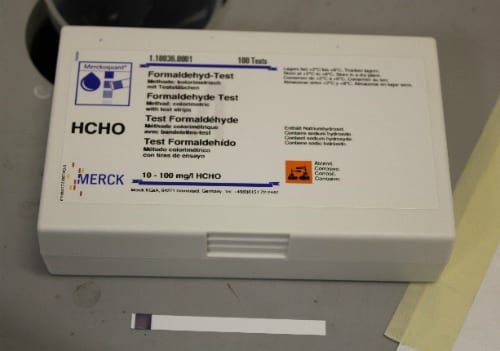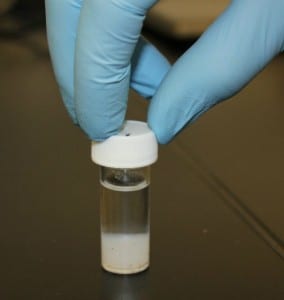Fluid Fish and Mystery Precipitate
By Emilia L Kingham, on 21 January 2016
Part of the work that we do as conservators for UCL’s Museums and Collections is to maintain the condition of the various collections. The Grant Museum of Zoology and Comparative Anatomy has approximately 300 fluid preserved specimens on display in the museum and 3500 fluid specimens in the stores.
These types of specimens need monitoring to make sure that the fluid in the jars has not evaporated, causing the specimen to dry out or decompose. I have been working through the specimens on display, making sure that they are first, not deteriorating, and second, that they look presentable for the public. No one wants to see a jar that is rotting and half-empty!
For one particular fluid specimen, Rhombus laevis (V238), a type of Brill, I thought I would be able to quickly top-up the fluid in the jar and the specimen would be beautiful and ready for display again. In general, most fluid specimens are preserved in a formaldehyde solution, e.g. formalin, or in a 70-80% alcohol solution. Since there were not any previous conservation records or details on the database about the type of fluid that this Brill was preserved in, I thought it best to do a quick formaldehyde spot test. The spot test was positive for formaldehyde, and corresponded to the highest concentration on the test comparison, 100mg/L HCHO.
Additionally our digital density meter, which reads the percent of alcohol in a solution, indicated no alcohol in the jar. Since I knew the current fluid was formalin, I added more formalin to the jar to fill it up and something surprising happened…the fluid started to go cloudy!
This reaction was almost instantaneous when I added the fresh formalin to the jar and it started to develop a build-up of white grainy precipitate material on the glass. This was an unusual occurrence and I was immediately intrigued to find out what this mystery substance was. A sample was collected for analysis, so watch this space for updates in the future! In the meantime, the specimen was removed from the cloudy fluid, rinsed of formalin, and placed into an alcohol solution ready to go back on display again.
Emilia Kingham is a Conservator for UCL Public and Cultural Engagement
One Response to “Fluid Fish and Mystery Precipitate”
- 1
 Close
Close








Hi Emilia,
di you find out what the precipitate was made of and why it appeared? I do have the same problem here with a bottle of formalin which I freshly made.
Kind regards,
Will